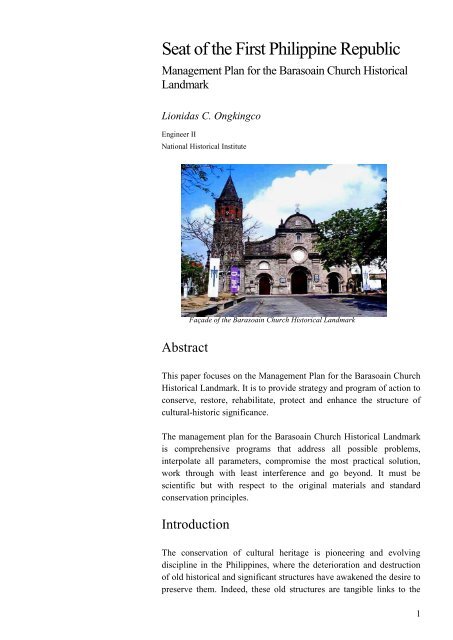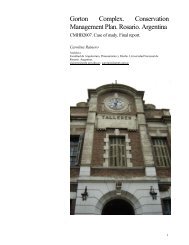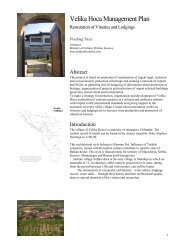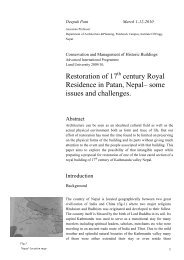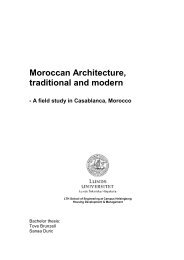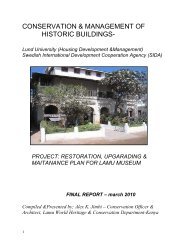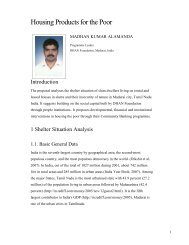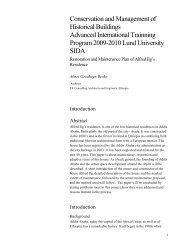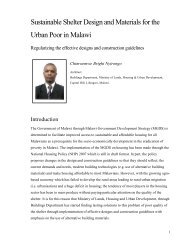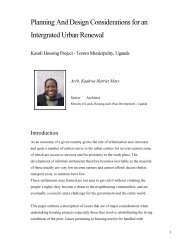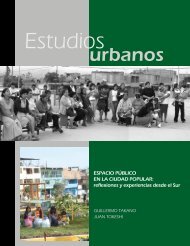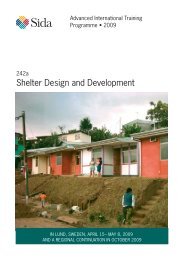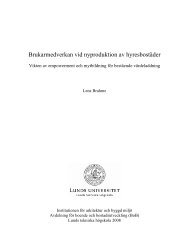Management Plan for the Barasoain Church Historical ... - HDM
Management Plan for the Barasoain Church Historical ... - HDM
Management Plan for the Barasoain Church Historical ... - HDM
You also want an ePaper? Increase the reach of your titles
YUMPU automatically turns print PDFs into web optimized ePapers that Google loves.
Seat of <strong>the</strong> First Philippine Republic<br />
<strong>Management</strong> <strong>Plan</strong> <strong>for</strong> <strong>the</strong> <strong>Barasoain</strong> <strong>Church</strong> <strong>Historical</strong><br />
Landmark<br />
Lionidas C. Ongkingco<br />
Engineer II<br />
National <strong>Historical</strong> Institute<br />
Façade of <strong>the</strong> <strong>Barasoain</strong> <strong>Church</strong> <strong>Historical</strong> Landmark<br />
Abstract<br />
This paper focuses on <strong>the</strong> <strong>Management</strong> <strong>Plan</strong> <strong>for</strong> <strong>the</strong> <strong>Barasoain</strong> <strong>Church</strong><br />
<strong>Historical</strong> Landmark. It is to provide strategy and program of action to<br />
conserve, restore, rehabilitate, protect and enhance <strong>the</strong> structure of<br />
cultural-historic significance.<br />
The management plan <strong>for</strong> <strong>the</strong> <strong>Barasoain</strong> <strong>Church</strong> <strong>Historical</strong> Landmark<br />
is comprehensive programs that address all possible problems,<br />
interpolate all parameters, compromise <strong>the</strong> most practical solution,<br />
work through with least interference and go beyond. It must be<br />
scientific but with respect to <strong>the</strong> original materials and standard<br />
conservation principles.<br />
Introduction<br />
The conservation of cultural heritage is pioneering and evolving<br />
discipline in <strong>the</strong> Philippines, where <strong>the</strong> deterioration and destruction<br />
of old historical and significant structures have awakened <strong>the</strong> desire to<br />
preserve <strong>the</strong>m. Indeed, <strong>the</strong>se old structures are tangible links to <strong>the</strong><br />
1
Lionidas C. Ongkingco<br />
Filipinos’ past and assist in maintaining its identity as a nation in <strong>the</strong><br />
rapidly changing scenes of development and modernization.<br />
Significant <strong>for</strong> <strong>the</strong>ir age and cultural values, <strong>the</strong>se ancient structures<br />
are indispensable media and sources of artistic and historic<br />
in<strong>for</strong>mation and thus, measures to preserve <strong>the</strong>m from <strong>the</strong> onslaughts<br />
of time, nature and man are imperative.<br />
Background<br />
Map of <strong>the</strong> Philippines<br />
Location<br />
<strong>Barasoain</strong> <strong>Church</strong> is situated near latitude 14°50’46.82”N and<br />
longitude 120°48’44.79”E. It is located near <strong>the</strong> town plaza of<br />
Malolos, <strong>the</strong> capital city of <strong>the</strong> province of Bulacan and about 50<br />
kilometers away from Manila. It is bounded by <strong>the</strong> towns of Calumpit,<br />
Plaridel, Sta. Isabel and Paombong.<br />
Map of Bulacan<br />
Aerial view of Barasaoin <strong>Church</strong> <strong>Historical</strong> Landmark from Google earth<br />
History<br />
The three centuries of Spanish rule in <strong>the</strong> country left long lasting<br />
legacies in <strong>the</strong> country. The culture of <strong>the</strong> Filipinos was inevitably<br />
inspired by <strong>the</strong> Iberian rule in <strong>the</strong> Philippines. From <strong>the</strong> food that we<br />
eat and even our names were rooted in <strong>the</strong> blood of our Spanish<br />
ancestry. Fur<strong>the</strong>rmore, <strong>the</strong> massive structures like churches and<br />
ca<strong>the</strong>dral are silent witness of that time. During <strong>the</strong> Spanish era,<br />
Christianity was introduced by missionaries who came to <strong>the</strong> country.
Old picture of <strong>Barasoain</strong> <strong>Church</strong><br />
<strong>Church</strong> main altar<br />
<strong>Management</strong> <strong>Plan</strong> <strong>for</strong> <strong>the</strong> <strong>Barasoain</strong> <strong>Church</strong> <strong>Historical</strong> Landmark<br />
They not only used <strong>the</strong> sword as part of controlling <strong>the</strong> country but<br />
also used <strong>the</strong> cross. The Spaniards <strong>for</strong>ced <strong>the</strong> Filipinos to construct<br />
churches as a place of worship. In <strong>the</strong> entire Philippines, <strong>the</strong>re are<br />
countless churches built during <strong>the</strong> Spanish period; a product of<br />
hardship and perseverance of many Filipinos. These churches served<br />
not only as a place of worship but also as a place of refuge during<br />
trying times.<br />
One of <strong>the</strong> more significant churches in <strong>the</strong> country is <strong>the</strong> <strong>Barasoain</strong><br />
<strong>Church</strong>. Located in Malolos, Bulacan, this church has contributed in<br />
<strong>the</strong> struggle <strong>for</strong> independence. <strong>Barasoain</strong> was a visita of Malolos from<br />
which it separated in 1859. The first parish priest, Fr. Francisco<br />
Arriola was appointed on June 1, 1859. He built its convent. A small<br />
ermita was constructed during <strong>the</strong> time of Fr. Melchor Fernandez in<br />
1816, which served as a temporary parish church. He was <strong>the</strong> priest of<br />
Malolos from 1816-1840. One of <strong>the</strong> existing bells in <strong>the</strong> church,<br />
dated 1870, was installed by Fr. Emeterio Ruperez, which was<br />
donated by <strong>the</strong> principalia of Malolos. It was dedicated to Our Lady of<br />
Carmel of <strong>Barasoain</strong>. The temporary chapel was replaced with a hewn<br />
stone church by Fr. Francisco Royo in 1871 and 1878 but was<br />
destroyed by fire later on. What was left was one of <strong>the</strong> bells that were<br />
installed by Fr. Royo on February 30, 1873 which was dedicated to St.<br />
Francis Xavier. During <strong>the</strong> term of Fr. Juan Giron, <strong>the</strong> chapel of <strong>the</strong><br />
cemetery was used until it was also destroyed during an earthquake of<br />
1880. He <strong>the</strong>n built a temporary chapel made of nipa and bamboo,<br />
however, it was burned down in 1884 during <strong>the</strong> solemn celebrations<br />
of <strong>the</strong> feast of Our Lady of Carmel. In 1885, Fr. Giron hired a<br />
contractor and started <strong>the</strong> construction of a massive church made of<br />
bricks and masonry. The church was completed under <strong>the</strong> supervision<br />
of Fr. Giron. However <strong>the</strong>re was no specific date of its completion.<br />
Some historian said that “at <strong>the</strong> time it was completed, <strong>the</strong> pockets of<br />
Fr. Giron were drained”, he might have put every penny <strong>for</strong> <strong>the</strong><br />
construction of <strong>the</strong> church. The construction of <strong>the</strong> tower and <strong>the</strong><br />
restoration of <strong>the</strong> convent started during <strong>the</strong> term of Fr. Martin<br />
Arconada in 1889. There were three bells installed in 1897. One of<br />
<strong>the</strong>m is dedicated to St. Martin and was donated by Fr. Arconada. The<br />
convent undertook ano<strong>the</strong>r restoration in 1894 by Fr. Miguel Vera.<br />
The <strong>Barasoain</strong> <strong>Church</strong> played a major role in <strong>the</strong> history of <strong>the</strong><br />
Philippines. Three important episodes in <strong>the</strong> history of <strong>the</strong> Philippines<br />
took place <strong>the</strong>re. After <strong>the</strong> declaration of <strong>the</strong> Philippine independence<br />
in Kawit, Cavite in June 12, 1898, Aguinaldo transferred his<br />
government to Malolos, Bulacan. The <strong>Barasoain</strong> <strong>Church</strong> became <strong>the</strong><br />
venue <strong>for</strong> <strong>the</strong> inauguration of <strong>the</strong> First Philippine Congress on<br />
September 15, 1898, <strong>for</strong> <strong>the</strong> drafting of <strong>the</strong> Malolos Constitution on<br />
September 29, 1898 to January 21, 1899 and <strong>for</strong> <strong>the</strong> inauguration of<br />
<strong>the</strong> First Philippine Republic on January 23, 1899. These events count<br />
among <strong>the</strong> proudest moments in <strong>the</strong> struggle of Filipinos <strong>for</strong> self-rule.<br />
<strong>Church</strong> two side altars<br />
In recent years, <strong>the</strong> buildings have undergone thorough restoration<br />
under <strong>the</strong> supervision of <strong>the</strong> National <strong>Historical</strong> Institute. Because of<br />
<strong>the</strong> significant events that took place in <strong>the</strong> said church and its
Lionidas C. Ongkingco<br />
convent, and its distinct architectural design, it was declared a<br />
National Landmark on August 1, 1973.<br />
Description of <strong>the</strong> Building<br />
<strong>Barasoain</strong> <strong>Church</strong> is a complex site of about 6,000 square meters<br />
consisting of <strong>the</strong> church proper, a belfry, a convent cloister, a front<br />
patio and an interior court.<br />
The features of <strong>the</strong> façade are Neo-classic in style. The semicircular<br />
pediment is like <strong>the</strong> opening bar to a symphony of variations on a<br />
circle motif. The shoulders of <strong>the</strong> pediment swing into curvilinear<br />
slopes and terminate in <strong>the</strong> contrapuntal sphere-topped urn finials. The<br />
smaller entrances are <strong>the</strong> repetitions of <strong>the</strong> main entrance with<br />
recessed arches rest on triple columns with graceful cylindrical shafts.<br />
The recurring melody is faintly played out in <strong>the</strong> arched niche on <strong>the</strong><br />
pediment, which is rendered deep and narrow by <strong>the</strong> recessed arch and<br />
by <strong>the</strong> slim obscure statue it houses. At present, it continues to<br />
function as a church.<br />
The belltower on <strong>the</strong> right side of <strong>the</strong> church rises from a cube and<br />
tapers into three layers, rhythmically accented by blind and open<br />
windows. Inverted scallops , metamorphosing at some point into<br />
simple plant <strong>for</strong>ms, run along <strong>the</strong> base of each layer like grace notes<br />
embellishing an o<strong>the</strong>rwise simple passage.<br />
The convent on <strong>the</strong> left side where <strong>the</strong> Universidad Literaria Cientifica<br />
de Filipinas was first housed is a combination of adobe and wood<br />
construction. At present, it features a light and sound museum under<br />
<strong>the</strong> management of <strong>the</strong> National <strong>Historical</strong> Institute.<br />
Analysis<br />
In 1997, <strong>the</strong> National Centennial Commission (NCC) initiated major<br />
restoration and development works <strong>for</strong> <strong>the</strong> <strong>Barasoain</strong> <strong>Church</strong> and<br />
Convent <strong>for</strong> <strong>the</strong> celebration of <strong>the</strong> centennial anniversary of <strong>the</strong><br />
Malolos Congress on September 15, 1998 and <strong>the</strong> First Philippine<br />
Republic on January 1999.<br />
Many parts of <strong>the</strong> structure were reconstructed in accordance with <strong>the</strong><br />
approved plans and concept <strong>for</strong> <strong>the</strong> National Centennial Celebrations.<br />
One of <strong>the</strong> crucial interventions was <strong>the</strong> reconstruction of <strong>the</strong> entire<br />
roofing system of <strong>the</strong> church. The new roofing system covered with<br />
replicas of clay tiles used in <strong>the</strong> 19 th century was constructed 3 meters<br />
higher than <strong>the</strong> original level. The marble flooring was replaced by <strong>the</strong><br />
checkerboard design of black and white cement tiles. The original<br />
motif and design of ceilings and walls are copied.
<strong>Management</strong> <strong>Plan</strong> <strong>for</strong> <strong>the</strong> <strong>Barasoain</strong> <strong>Church</strong> <strong>Historical</strong> Landmark<br />
The ground floor adobe walls of <strong>the</strong> convent were retained and most<br />
of <strong>the</strong> wooden components at <strong>the</strong> second floor were replaced. At<br />
present <strong>the</strong> structure is used by <strong>the</strong> NHI as office and museum.<br />
Additional structures with design simulated of that of <strong>the</strong> existing<br />
convent were also built to house <strong>the</strong> ecclesiastical museum, office of<br />
<strong>the</strong> parish and <strong>the</strong> residence of <strong>the</strong> parish priest.<br />
As a whole <strong>the</strong> original features of <strong>the</strong> church were preserved, and<br />
because of its historical contribution, tourists and visitors from<br />
different places and localities always include <strong>Barasoain</strong> church<br />
<strong>Historical</strong> Landmark in <strong>the</strong>ir itinerary of important historical places to<br />
visit in Bulacan.<br />
The church and its facilities are being maintained with continuous<br />
support from <strong>the</strong> national government, local government, o<strong>the</strong>r<br />
institution and <strong>the</strong> church.<br />
Value Typologies<br />
• <strong>Historical</strong> Value<br />
The <strong>Barasoain</strong> <strong>Church</strong> <strong>Historical</strong> Landmark is popularly known<br />
as <strong>the</strong> seat of <strong>the</strong> Malolos Congress of September 15, 1898, <strong>for</strong> <strong>the</strong><br />
drafting of <strong>the</strong> Malolos constitution on September 29, 1898 and<br />
<strong>the</strong> site of <strong>the</strong> inauguration of <strong>the</strong> First Philippine Republic in<br />
January 23, 1899.<br />
A session during <strong>the</strong> First Philippine Congress in Malolos<br />
• Religious Value<br />
A Roman Catholic <strong>Church</strong>, <strong>Barasoain</strong> become an independent<br />
parish in 1859 dedicated to Our Lady of Mount Carmel. It was one<br />
of <strong>the</strong> countless churches built during Spanish period as a place of<br />
worship.
Lionidas C. Ongkingco<br />
• Educational Value<br />
The Universidad Literaria Cientifica de Filipinas was first<br />
housed in <strong>the</strong> <strong>Barasoain</strong> convent. It offered Law as well as<br />
Medicine, Surgery and Notary Public, <strong>the</strong> Academia Militar and<br />
<strong>the</strong> Burgos Institute, an exclusive school <strong>for</strong> boys. Today, <strong>the</strong><br />
convent houses different museum, a place of in<strong>for</strong>mal learning. It<br />
tries to carry lessons from history and <strong>the</strong> importance of civic<br />
duties.<br />
• Associational Value<br />
The site serves as <strong>the</strong> haven of <strong>the</strong> Congreso Revolucionario<br />
during <strong>the</strong> Philippine revolution with <strong>the</strong> ilustrados as its<br />
delegates and Gen. Emilio Aguinaldo as <strong>the</strong> leader.<br />
• Au<strong>the</strong>ntic Value<br />
Founded by Augustinian Missionaries, it was originally built<br />
in 1630. Even if it was destroyed by fire on 1884 that caused<br />
reconstruction and various renovations, <strong>the</strong> structure itself was<br />
very similar to <strong>the</strong> church during Spanish era with neo-classic<br />
style features of <strong>the</strong> façade.<br />
Current Issues and Problems<br />
1. The adobe wall shows powdering (pulverization) while some are<br />
chipped and cracked. Proper consolidation is needed.<br />
2. Some wooden parts are rotted and deteriorated due to<br />
wea<strong>the</strong>ring.<br />
3. Termite infestations on wooden components are observed.<br />
4. Capiz shell windows are currently tarnished.<br />
5. Presence of botanical growth and black deposits on stone walls.<br />
6. The need of skylight roofing at <strong>the</strong> azotea to prevent <strong>the</strong> area<br />
from deterioration. This can be use as an additional function<br />
room.<br />
7. Rusted window grills<br />
8. Door pivot and locks are deteriorated and some are not<br />
functional.<br />
9. Gaps on some part of <strong>the</strong> stone walls<br />
10. Some wooden window grills and wood balusters are missing and<br />
o<strong>the</strong>rs are broken.<br />
11. Vigan tiles at <strong>the</strong> azotea area are chipped while o<strong>the</strong>rs are<br />
deteriorated.<br />
12. Some painted parts show blotches.
<strong>Management</strong> <strong>Plan</strong> <strong>for</strong> <strong>the</strong> <strong>Barasoain</strong> <strong>Church</strong> <strong>Historical</strong> Landmark<br />
Proposed <strong>Management</strong> <strong>Plan</strong><br />
This historic structure is intact and currently in-use. Taking care of <strong>the</strong><br />
church and its facilities shall protect it from decay and attain<br />
development. The maintenance plan shall be <strong>the</strong> continuity of <strong>the</strong><br />
process of protecting <strong>the</strong> built heritage in long term perspective. An<br />
estimated budget of Php 3,000,000.00 (approximately US$ 64,000)<br />
must be allotted yearly <strong>for</strong> <strong>the</strong> maintenance program of <strong>the</strong> church and<br />
convent.<br />
Maintenance and repair<br />
Item Daily Weekly Monthly Semiannual<br />
1. Mop <strong>the</strong> floor √<br />
2. Dust window sills,<br />
exhibition panels,<br />
counter tops and voting<br />
booths<br />
3. Wipe off finger marks on<br />
glass panels<br />
4. Removal of garbage √<br />
5. Remove cobwebs and<br />
molds from walls and<br />
ceiling<br />
6. Application of wax to<br />
<strong>the</strong> floor<br />
7. Wipe lighting fixtures √<br />
8. Wipe off dust which may<br />
cling to outer windows<br />
and outer walls of <strong>the</strong><br />
church and convent<br />
9. Assign a staff member to<br />
inspect <strong>for</strong> termites and<br />
insect borers<br />
10. Cleaning and<br />
maintenance of <strong>the</strong><br />
statue of saints and o<strong>the</strong>r<br />
display<br />
11. Proper disposal of<br />
waste<br />
12. Establish positions and<br />
activities of each<br />
√<br />
√<br />
√<br />
√<br />
√<br />
√<br />
√<br />
√<br />
√
Lionidas C. Ongkingco<br />
employee<br />
13. Prepare a safety and<br />
health environmental<br />
management plan<br />
14. Interact with <strong>the</strong><br />
community by<br />
conducting seminars,<br />
lectures and <strong>the</strong> like.<br />
√<br />
√<br />
Conservation / Restoration <strong>Plan</strong><br />
A. Belltower<br />
1.0 Restoration of church belltower<br />
1.1 Documentation<br />
1.1.1 Measured drawings<br />
1.1.2 Photo documentation be<strong>for</strong>e during and<br />
after restoration<br />
1.2 Cleaning works<br />
1.2.1 Mechanical cleaning<br />
1.2.2 Chemical cleaning<br />
1.3 Stone consolidation/re-grouting of walls<br />
1.4 Installation of neon lightings at <strong>the</strong> cross on top of<br />
<strong>the</strong> belltower<br />
1.5 Replacement of existing wood hangers to double<br />
strut trusses <strong>for</strong> <strong>the</strong> main bell<br />
1.6 Improvement of belltower floor drainage<br />
B. <strong>Church</strong><br />
1.0 Documentation<br />
1.1 Measured drawings<br />
1.2 Photo documentation be<strong>for</strong>e during and after<br />
restoration<br />
2.0 Restoration of church exterior<br />
2.1 Cleaning works<br />
2.1.1 Mechanical cleaning<br />
2.1.2 Chemical cleaning<br />
2.2 Re-pointing of decayed mortar joints<br />
2.3 Consolidation of stone walls<br />
2.4 Finishing works<br />
3.0 Restoration of church interior<br />
3.1 Periodic inspection and rehabilitation of <strong>the</strong> roofing<br />
system
<strong>Management</strong> <strong>Plan</strong> <strong>for</strong> <strong>the</strong> <strong>Barasoain</strong> <strong>Church</strong> <strong>Historical</strong> Landmark<br />
3.2 Periodic inspection and rehabilitation of ceiling<br />
system<br />
3.3 Repair/replacement of structural wooden<br />
components<br />
3.4 Repair/replacement of architectural wooden<br />
components<br />
3.5 Replacement of damaged floor tiles<br />
3.6 Retrofitting of wooden doors and windows<br />
3.7 Gold leafting of main and side altars<br />
3.8 Periodic inspection and rehabilitation of electrical<br />
system<br />
3.9 Provision of protection from bird/bat droppings<br />
3.10 General repainting and varnishing<br />
3.11 Treatment of wooden components with termiticides<br />
3.12 Installation and maintenance of in-ground termite<br />
bait system<br />
C. Convent<br />
1.0 Restoration of BCHL History Museum<br />
1.1 Documentation<br />
1.1.1 Measured drawings<br />
1.1.2 Photo documentation be<strong>for</strong>e during and<br />
after restoration<br />
1.2 Repair/replacement of structural wooden<br />
components<br />
1.3 Repair/replacement of architectural wooden<br />
components<br />
1.4 Replacement of damaged tegula tile roofing<br />
1.5 Replacement of damaged corrugated G.I. roofing<br />
1.6 Repair/retrofitting of wooden capiz windows<br />
1.7 Replacement of wooden window grills<br />
1.8 Provision of security grills <strong>for</strong> exhaust system<br />
1.9 Removal of botanical growth on <strong>the</strong> exterior walls<br />
1.10 Chemical cleaning of stone walls<br />
1.11 Consolidation of stone walls<br />
1.12 Treatment of wooden components with termiticides<br />
1.13 Installation and maintenance of in-ground termite<br />
bait system<br />
1.14 Periodic inspection and maintenance of electrical<br />
system<br />
1.15 Water proofing of azotea at <strong>the</strong> second floor<br />
1.16 Provision of skylight roofing system at <strong>the</strong> azotea
Lionidas C. Ongkingco<br />
1.17 Provision of office/library equipment and furniture<br />
1.18 General repainting and varnishing<br />
1.19 Replacement of deteriorated vigan tiles<br />
2.0 Restoration of Diocesano de Malolos (Ecclesiastical<br />
Museum)<br />
2.1 Documentation<br />
2.1.1 Measured drawings<br />
2.1.2 Photo documentation be<strong>for</strong>e during and<br />
after restoration<br />
2.2 Repair/replacement of structural wooden<br />
components<br />
2.3 Repair/replacement of architectural wooden<br />
components<br />
2.4 Treatment of wooden components with termiticides<br />
2.5 Installation and maintenance of in-ground termite<br />
bait system<br />
2.6 Periodic inspection and maintenance of electrical<br />
system<br />
2.7 Restoration of library hall<br />
2.8 Restoration of multi-purpose hall<br />
2.9 Provision of cabinets and showcases<br />
2.10 Modification of staircases leading to both museum<br />
2.11 Provision of security cameras and T.V. monitor<br />
2.12 General repainting and varnishing<br />
D. <strong>Church</strong> Yard<br />
Method<br />
1.0 Repair/replacement of outdoor lighting receptacles and<br />
fixtures<br />
2.0 Installation of flag poles (evolution of Philippine flag) at<br />
<strong>the</strong> church plaza<br />
3.0 Upgrading of <strong>the</strong> Glorietta (Gazebo)<br />
4.0 Re-development of drainage system<br />
5.0 Provision of waste management program<br />
In management planning thorough research, survey and<br />
documentation are necessary. The <strong>Barasoain</strong> <strong>Church</strong> and convent is a<br />
structure built of bricks, masonry and wood subject to periodic check<br />
up, cleaning and replacement of deteriorated parts.
<strong>Management</strong> <strong>Plan</strong> <strong>for</strong> <strong>the</strong> <strong>Barasoain</strong> <strong>Church</strong> <strong>Historical</strong> Landmark<br />
Documentation is required in all stages of work, it include actual<br />
measurements of <strong>the</strong> church and plotting it in <strong>for</strong>m of plans, elevation<br />
and section. Photo documentation is also necessary that can be use as<br />
a reference <strong>for</strong> future restoration.<br />
Mechanical cleaning usually involves dry brushing to remove<br />
loosely bound materials, dirt and organic growth on <strong>the</strong> stone and<br />
masonry surface.<br />
Chemical cleaning is a cleaning process which applies chemical<br />
solution on <strong>the</strong> surface to be cleaned to remove or extract <strong>the</strong><br />
unwanted elements or superficial, an initial stage of intervention in<br />
preparation <strong>for</strong> <strong>the</strong> consolidation of <strong>the</strong> material.<br />
Grouting injection can be used to improve <strong>the</strong> homogeneity and<br />
strength of weak and porous mortar. This is done by filling <strong>the</strong><br />
cavities and bonding <strong>the</strong> faces of crossing cracks.<br />
Repointing is a remedial treatment with <strong>the</strong> aim of sealing gaps,<br />
filling small cavities and replacing decayed mortar joints. It is <strong>the</strong><br />
method of introducing new mortars with <strong>the</strong> use of a pointing device<br />
or pointing iron.<br />
Termite treatment of all wooden components and ground should be<br />
per<strong>for</strong>med by a license and professional termite applicator.<br />
Bird/Bat droppings protection. Bird and bat droppings are not only<br />
unsightly but potentially harmful to stone, nets may be improvised or<br />
installed to control entry of birds and bats in <strong>the</strong> buildings.<br />
Consolidation is an act of direct intervention or preservation to<br />
prevent, stop or retard deterioration, it is <strong>the</strong> physical addition or<br />
application of adhesive or supportive materials into <strong>the</strong> actual fabric of<br />
<strong>the</strong> structure.<br />
Results/Current Status of <strong>the</strong> Work<br />
The planning is still in progress. Coordination between <strong>the</strong> concerned<br />
institutions and organizations are still on-going. The proposed<br />
program of works has been done to raise funding from local and<br />
international organization.
Lionidas C. Ongkingco<br />
Discussion & Conclusions<br />
As with all areas of historic preservation, prudence and a systematic<br />
approach are required. Problems must be fully understood be<strong>for</strong>e<br />
attempts are made to solve <strong>the</strong>m, and we must be aware of <strong>the</strong><br />
ramifications of our methods be<strong>for</strong>e we employ <strong>the</strong>m.<br />
An attempt at restoration that irreversibly alters or damages a structure<br />
might best not have been attempted.<br />
Although <strong>the</strong> <strong>Barasoain</strong> <strong>Church</strong> has been declared a National<br />
<strong>Historical</strong> Landmark by <strong>the</strong> Philippine government, conservation<br />
measures are still needed to properly safeguard and manage <strong>the</strong><br />
existing heritage structure.<br />
References<br />
1. Galende, Pedro G., OSA<br />
1996, Angels in Stone<br />
Augustinian <strong>Church</strong>es in <strong>the</strong> Philippines<br />
2. Galende, Pedro G., OSA<br />
2007, Philippine <strong>Church</strong> Facades<br />
3. Santos, Mariano<br />
2001, Aklat ng Bayan ng Bulacan<br />
4. National <strong>Historical</strong> Institute<br />
1993, <strong>Historical</strong> Markers<br />
Region I-IV and CAR<br />
5. NHI Brochures<br />
6. National <strong>Historical</strong> Institute<br />
2005, A Technical Note on <strong>the</strong> Restoration of Stone<br />
and Masonry in Historic Buildings<br />
7. Jose, Ricardo T.<br />
1998, The Japanese Occupation<br />
8. Sta. Maria, Felice Prudente<br />
1998, Vision of <strong>the</strong> Possible Legacies of Philippine Freedom
<strong>Management</strong> <strong>Plan</strong> <strong>for</strong> <strong>the</strong> <strong>Barasoain</strong> <strong>Church</strong> <strong>Historical</strong> Landmark<br />
9. Ignacio, Abe et.al.<br />
2004, The Forbidden Book<br />
First Edition<br />
Acknowledgement<br />
National <strong>Historical</strong> Institute – Historic Preservation Division<br />
Arch. Reynaldo A. Inovero<br />
Engr. Candido H. Castro<br />
Ms. Monalisa Quizon - RPHD<br />
Mr. Alvin Alcid - HSED<br />
Arch. Wilkie Delumen<br />
Arch. Ma. Luisa Valerio<br />
Mr. Oliver Navato<br />
Ms. Apple Agtonong
Lionidas C. Ongkingco<br />
Appendix 1<br />
Key <strong>Plan</strong> (A)<br />
(1) CONVENT<br />
(2) ECCLESIASTICAL MUSEUM<br />
(3) NHI MUSEUM<br />
(4) NHI OFFICE<br />
(5) PARISH OFFICE<br />
(6) SIDEVIEW OF THE CHURCH<br />
(7) BARASOAIN CHURCH<br />
(8) UNIVERSITY OF REGINA CARMELI
<strong>Management</strong> <strong>Plan</strong> <strong>for</strong> <strong>the</strong> <strong>Barasoain</strong> <strong>Church</strong> <strong>Historical</strong> Landmark<br />
Appendix 2<br />
Key <strong>Plan</strong> (B)<br />
(1) PREPARATORY SCHOOL<br />
(2) PUBLIC TOILET<br />
(3) VIRGIN MARY & JESUS<br />
(4) STATUE OF JESUS<br />
(5) GLORIETA<br />
(7) MARKER FOR<br />
CENTENNIAL<br />
FREEDOM TRAIL<br />
(6) GROTTO TO THE<br />
VIRGIN MARY<br />
(8)AGUINALDO MONUMENT
Lionidas C. Ongkingco<br />
Appendix 3<br />
Floor <strong>Plan</strong>s
<strong>Management</strong> <strong>Plan</strong> <strong>for</strong> <strong>the</strong> <strong>Barasoain</strong> <strong>Church</strong> <strong>Historical</strong> Landmark<br />
Appendix 4<br />
Floor <strong>Plan</strong> and Elevation
Lionidas C. Ongkingco<br />
Appendix 4


